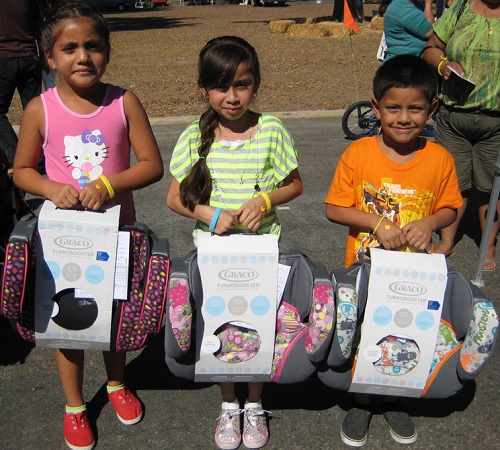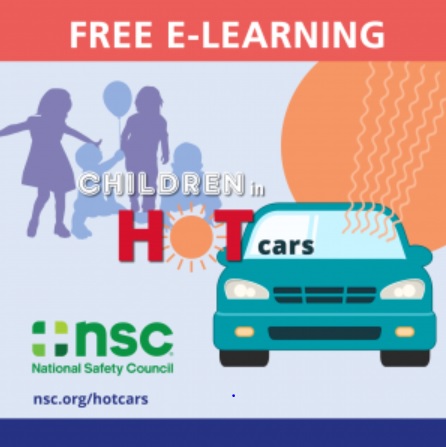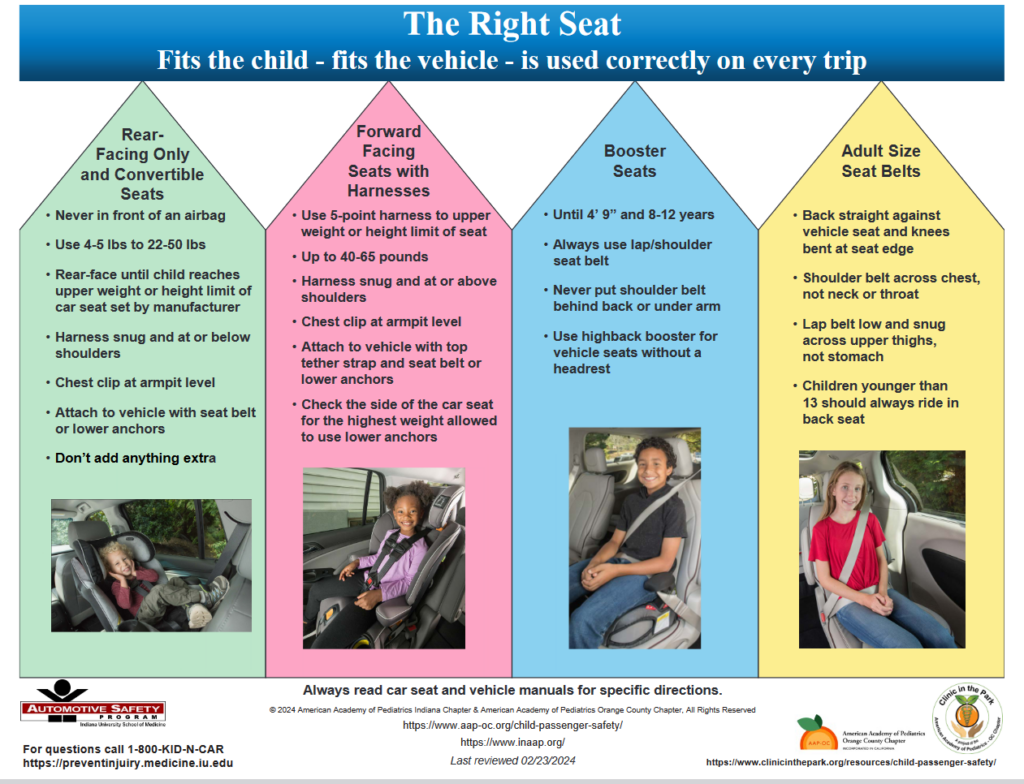An important part of our work is making sure that children are safe while traveling in a car!
You can keep your kids safe by following these basic practices:
- Be sure that your children travel in a size-appropriate car seat in every car and on every trip.
- Share our parent guide, The Right Seat, which covers seat selection, position, and location in the car. We offer the guide in English, Spanish, Vietnamese Korean, Arabic, Farsi, Simplified Chinese and Traditional Chinese versions.
- Be sure that all adolescents and adults are buckled up during every car trip.
- Remember that distracted drivers put us all at risk. The cell phone should not be used while driving. 22% of child passengers who are killed are involved in crashes that involve impaired drivers. In fact, over half are riding with the impaired driver.
Click here to download the Orange County Child Passenger Safety Resource Guide, which provides information on how low-income families can receive free car seats; how to schedule a car seat inspection by certified technicians; details about educational classes; and instructions on installing a car seat for your child.
Click here to watch the AAP-OC video presentation on car seat & booster seat safety.
Click here to download slides from our Clinic in the Park Car Seat/Booster Seat Safety Workshop
Click here to access the Orange County Car Seat Safety Program webpage.
Click here to download the California Department of Health & Office of Traffic Safety brochure (English)
Click here to download the California Department of Health & Office of Traffic Safety brochure (Spanish)
Data informs policy: California’s First Child Passenger Law. Our UC Irvine Childhood Injury Prevention Research Team (Agran, Winn, Anderson) was awarded a grant in the 1980s by then-Director of the California Office of Traffic Safety, Tom Lankard to conduct research documenting that the risk of a car crash injury was reduced if the child was in a car seat compared to traveling unrestrained. This led to Larry Agran working with then-Assemblymember Mel Levine to craft what became SB 537, Child Seat Restraint Bill (1982). This was the first statewide child passenger safety law that has since been incrementally improved.
- Children under 2 years of age shall ride in a rear-facing car seat unless the child weighs 40 or more pounds OR is 40 or more inches tall. The child shall be secured in a manner that complies with the height and weight limits specified by the manufacturer of the car seat. (California Vehicle Code Section 27360.)
- Children under the age of 8 must be secured in a car seat or booster seat in the back seat.
- Children who are 8 years of age OR have reached 4’9” in height may be secured by a booster seat, but at a minimum must be secured by a safety belt. (California Vehicle Code Section 27363.)
- Passengers who are 16 years of age and over are subject to California’s Mandatory Seat Belt law.
Boosters-in-a-Bag Project
Clinic in the Park’s Boosters-in-a-Bag project was established to ensure children are riding correctly in every car on every trip. The project educates caregivers on the importance of a properly fitted vehicle safety belt and provides booster seats to children in need.
 The Boosters-in-a-Bag project helps meet the needs of families every step of the way. We partner with collaborators — including but not limited to family resource centers, school districts, clinics, community-based nonprofit organizations and local police and public safety departments that provide services to children and families. Our partners and our pediatricians identify families in Orange County with children who are in need of a car seat or booster seat.
The Boosters-in-a-Bag project helps meet the needs of families every step of the way. We partner with collaborators — including but not limited to family resource centers, school districts, clinics, community-based nonprofit organizations and local police and public safety departments that provide services to children and families. Our partners and our pediatricians identify families in Orange County with children who are in need of a car seat or booster seat.
Each year, Clinic in the Park distributes more than 300 booster seats/convertible car seats to the County’s underserved population.
We include parent drivers or parents who rely on others to transport themselves and their children. These parents are contacted and provided a link to a short, comprehensive, and self-guided online educational course.
The course is available in English and Spanish and covers:
- Current California child passenger laws
- The purpose of a booster seat
- How to use a booster seat
- When to transition out of a booster seat into a properly fitted safety belt
Click here to download the presentation from the workshop.
Once the course is complete, families are scheduled for a quick and convenient curbside pickup of their Boosters-in-a-Bag, which includes a new booster seat, child passenger safety educational materials for drivers, and supplies for their child passenger to create a safety message.
The Boosters-in-a-Bag project is focused on our most vulnerable Orange County Families, supporting enhanced education of all parents and caregivers as part of our advocacy to ensure the safety of our community’s youth.
If you are interested in our child passenger safety project with our certified Child Passenger Safety Technician Instructor (STAC), contact us at (949) 269-7819 or email info@clinicinthepark.org.

FREE Online Course from the NSC: Children in Hot Cars
According to the American Academy of Pediatrics Parenting Website, HealthyChildren.org, a child left in a hot car — or who gets into an unlocked vehicle unnoticed — can die of heat stroke very quickly. Every year, dozens of children in the United States lose their lives this way. But these tragedies can be prevented.
Facts about hot cars & heat stroke:
- Heat stroke is the leading cause of non-crash, vehicle-related deaths in children under 15. Heat stroke happens when the body is not able to cool itself quickly enough.
- A child’s body heats up three to five times faster than an adult’s does.
- When left in a hot car, a child’s major organs begin to shut down when his temperature reaches 104 degrees Fahrenheit (F).
- A child can die when his temperature reaches 107 degrees F.
- Cars heat up quickly! In just 10 minutes, a car can heat up 20 degrees F.
- Cracking a window and/or air conditioning does little to keep it cool once the car is turned off.
- Heat stroke can happen when the outside temperature is as low as 57 degrees F.
- Because of climate change, we can expect more days to be hotter. Also, hotter days can happen throughout the year.
The National Safety Council (NSC) offers a free online course to teach you about the dangers of leaving a child in a hot car.
The course covers the three primary circumstances that have led to children dying and what we all can do to prevent these deaths.
This free course is available in English and in Spanish. A certificate of completion is provided at the end of the training.
Documentary: Fatal Distraction
A powerful new documentary entitled Fatal Distraction, is now available on iTunes. The film includes interviews with the president and founder of the nonprofit organization Kids and Car Safety, Janette Fennell as well as a number of Kids and Car Safety parent advocates who have experienced the tragic loss of a child in a hot car.


